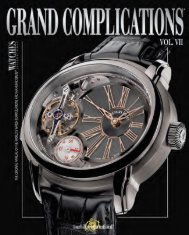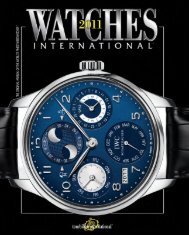180 YEARS OF
180 YEARS OF
180 YEARS OF
Create successful ePaper yourself
Turn your PDF publications into a flip-book with our unique Google optimized e-Paper software.
arely ever needed, Longines wanted the best of all possible<br />
solutions. is watch movement was certainly the<br />
best that the market had to oer at that time.<br />
LARGER SIZE, GREATER ACCURACY<br />
In 1938 Longines developed a chronograph that was specially<br />
designed for use at major sporting events. For the<br />
design of the giant 24-lignes (54.14-mm) movement,<br />
Longines’s engineers took the highly accurate Cal. 24.99<br />
from 1908. Longines had achieved great notoriety at<br />
chronometer competitions in Neuchâtel, Kew-Teddington<br />
and Washington D.C. with this movement. From the<br />
very beginning, exibility was emphasized in upgrading<br />
its mechanics. e chronograph was introduced in 1939<br />
in a basic version with a semi-instantaneous 30-minute<br />
totalizer that measured elapsed time to the exact 1/5 of a<br />
second, thanks to its large screw balance that oscillated at<br />
a frequency of 2.5 hertz. Its intended use at sports competitions<br />
made the split seconds indispensable. However,<br />
Longines’s engineers decided against placing the<br />
mechanism on the back of the movement. Instead, they<br />
positioned the column wheel, braking lever, splitseconds<br />
wheel and its operating lever directly on the<br />
front of the plate. is made the long, very delicate splitseconds<br />
arbor no longer essential, but servicing the<br />
watch required the removal of the hands and dial. An advanced<br />
feature of this chronograph rattrapante with two<br />
pushers was a hack mechanism to ensure precise setting<br />
to the exact second. Variations with a smaller balance<br />
and a frequency of ve hertz accurately recorded time intervals<br />
to the 1/10 second but did not show the time. is<br />
was also the case with the chronograph that measured<br />
the smallest time interval, which was produced well into<br />
the quartz era of the 1970s. In this case, the 1/100-second<br />
measurement was possible thanks to a balance frequency<br />
of 50 Hertz.<br />
The split-seconds chronograph<br />
based on Cal. 19.73N was<br />
certainly THE BEST that the<br />
market had to offer at that time.<br />
Hand-wind Cal. 262<br />
with split-seconds<br />
function, diameter =<br />
24 lignes, height =<br />
14.55 mm; 36,000<br />
vph. Production<br />
began in 1966.<br />
Elapsed Time | CHRONOGRAPHS<br />
Even though Longines revolutionized the timing of<br />
sporting events in 1954 with its quartz-controlled photo-<br />
nish system “Chronocinégines,” the company continued<br />
to manufacture mechanical pocket chronographs.<br />
Ocial timekeepers placed their trust in these instruments<br />
because of their proven reliability and precision<br />
and could not put their full condence behind modern<br />
electronics, always relying on back-up timers. For this<br />
reason Longines developed the 24-lignes split-seconds<br />
chronograph again in the 1950s, which produced the<br />
large, technically complex Cal. 260 in 1957 that could<br />
time events accurately to a 1/10 second. In contrast to the<br />
previous model, the added feature for the rattrapante was<br />
again placed on the conventional side of the movement,<br />
the back. Its most unusual feature consisted of the rotational<br />
speed of the chronograph and its split-seconds<br />
hands. Only 30 seconds – not 60 – were needed to circle<br />
the dial, and that allowed for a wider and more precise<br />
scale. However, timekeepers were unhappy with the<br />
modied dial design. Precise reading of elapsed intervals<br />
was possible only in conjunction with the contrasting<br />
LONGINES SPECIAL WatchTime | 43

















